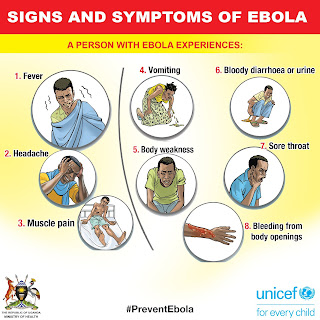Key Populations’ Readiness Tips About Ebola
The Ministry of Health (MoH) has put in place measures to manage Ebola in case it appears in the country.
This done with the help and support from Development Partners. The Government of Uganda, determines whether an event constitutes a public health emergency of international concern (PHEIC).
This done with the help and support from Development Partners. The Government of Uganda, determines whether an event constitutes a public health emergency of international concern (PHEIC).
It set up the National Ebola Preparedness and Response Contingency Plan, which combats the spread should there be a case. It has also put the health workers in various facilities on high alert to be watchful of various patients taken ill. These are called Ebola Treatment Units (ETU). That part of a team that scours the country in case of emergency is called the Ebola Rapid Response Team (RRTs). For more, please follow this link.
On top of physical structures, the MoH sends out regular notices and has a hotline operated by an Emergency Operations Centre.
The public is argued to remain vigilant and report any suspected cases of persons presenting symptoms and with a history of recent travel to affected countries, to the nearest health facility or Health’s Emergency Operations Centre .
The numbers to call/ hotlines:
+256732353535
+256729471414
080010066
You can send text messages to: Ureport 8500
080010066
You can send text messages to: Ureport 8500
Ebola is highly infectious and kills very quickly
When the disease breaks out , it is called Ebola Virus Disease (EVD)
Shaking hands with a person who is infected with Ebola transmits the disease
During an Ebola outbreak, avoid bush-meat, as it can affect you with Ebola
The signs and symptoms for Ebola are: fever, headache, muscle pain, vomiting, body weakness, bloody diarrhoea, bloody urine, sore throat, bleeding from body openings
Prevent Ebola by regular hand wash with soap and water; keep latrines, shutters and environ clean; regularly wash all utensils and clothes
A person gets Ebola by coming in direct contact with: body fluids of a person who has Ebola, a person who has died of Ebola, infected blood, vomit, urine, feaces, sweat, saliva
A person gets Ebola by coming in direct contact with: objects or materials contaminated with virus such as needle and medical equipment
A person gets Ebola by coming in direct contact with: with infected primates and bats
A person gets Ebola by coming in direct contact with: semen, saliva, mucous during sexual intercourse ( anal, vaginal and oral) from a person who has had Ebola or recovering from Ebola and has not yet been followed up to prove the person is Ebola-free
Ebola spreads through: touching a person who has died of Ebola; touching the clothes of a person with Ebola; lifting a person who has Ebola without proper protection; having sexual intercourse with a person infected with Ebola; touching the person infected with Ebola.
As key Populations are empowered to take lead in the HIV eradication, it is imperative that they are aware of the contexts within which they are working. Ebola is one such infection anyone who comes in contact with bed-ridden persons should watch out for by knowing symptoms and having their ear to the ground.



Comments
Post a Comment